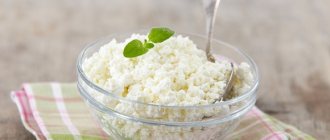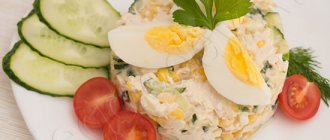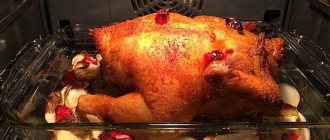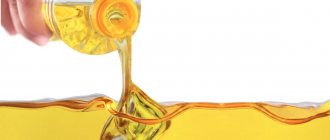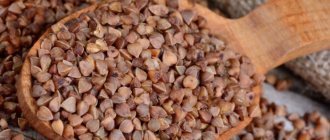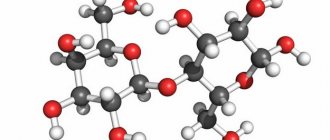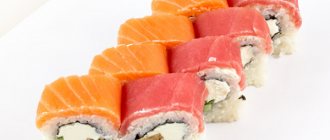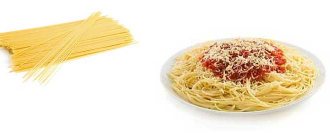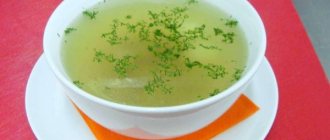Products
Calories and health benefits of chicken breast
6,615 2 minutes to read
Chicken breast is the basis of a diet for weight loss and many adherents of a healthy diet and lifestyle. It is an excellent source of lean protein. Dieters who consume enough protein will maintain muscle mass and a healthy metabolism. However, calculating the amount of chicken breast per 100 grams and the number of kcal contained in a chicken breast can be a difficult task, since its nutritional value depends on many factors.
- Calories and carbohydrates in chicken breast
- Health Benefits of Breast
- Selection and preparation
- Healthy cooking methods
- Recipes and cooking tips
- Afterword
Calories and carbohydrates in chicken breast
Table - Nutritional value of skinless and boneless chicken breast
| Serving size - 80 grams | |
| Daily Value per serving in %* |
| Total fat 2g | 10% |
| Saturated fat 2g | 9% |
| Polyunsaturated fat 0g | |
| Monounsaturated fat 1g | |
| Cholesterol 53mg | 18% |
| Sodium 46 mg | 2% |
| Potassium 159 mg | 3% |
| Carbohydrates 0.5 g | |
| Protein 29.8 g | |
| Vitamin A 0% Vitamin C 0% | |
| Calcium 1% Iron 4% | |
| *Based on a 2000 calorie diet | |
Chicken breasts are a great source of protein and contain almost no fat or sodium. They also have zero grams of carbohydrates, making them the ultimate low-carb food available. The approximate glycemic index for chicken breast (raw, skinless, boneless) is zero. Because it is such a versatile food, it can easily be included in any healthy diet.
To calculate how many calories are in chicken breast, you need to consider the cooking method and additional sources of calories that may be used during cooking. First of all, it is affected by the size of the chicken breast. One serving usually weighs about 100 grams and is about the size of your palm.
Many packaged chicken breast portions, however, are much larger. So if you decide to use it, most likely your portion is larger.
And, of course, if you leave the skin on the fillet, this immediately increases the proportion of fat, calories and energy value. A whole chicken breast with skin contains 366 calories, 55 grams of protein, 0 grams of carbohydrates, 14 grams of fat, 4 grams of saturated fat and 132 milligrams of sodium.
The cooking method, as well as any sauces or dressings you add to it, also make adjustments. 85 grams of grilled chicken contains 170 calories, 1 gram of carbohydrates, 11 grams of fat and 15 grams of protein.
One medium-roast chicken breast contains 364 calories, 34 grams of protein, 13 grams of carbohydrates, 18 grams of fat and 697 milligrams of sodium. Boiled chicken breast with 113 calories is a different story
Recipe: Fried chicken breast. Calorie, chemical composition and nutritional value.
Nutritional value and chemical composition of “Fried Chicken Breast”.
The table shows the nutritional content (calories, proteins, fats, carbohydrates, vitamins and minerals) per 100 grams of edible portion.
| Nutrient | Quantity | Norm** | % of the norm in 100 g | % of the norm in 100 kcal | 100% normal |
| Calorie content | 149.2 kcal | 1684 kcal | 8.9% | 6% | 1129 g |
| Squirrels | 21.5 g | 76 g | 28.3% | 19% | 353 g |
| Fats | 5.6 g | 56 g | 10% | 6.7% | 1000 g |
| Carbohydrates | 2.3 g | 219 g | 1.1% | 0.7% | 9522 g |
| Alimentary fiber | 1.2 g | 20 g | 6% | 4% | 1667 g |
| Water | 68.5 g | 2273 g | 3% | 2% | 3318 g |
| Ash | 0.2 g | ~ | |||
| Vitamins | |||||
| Vitamin B1, thiamine | 0.014 mg | 1.5 mg | 0.9% | 0.6% | 10714 g |
| Vitamin B2, riboflavin | 0.007 mg | 1.8 mg | 0.4% | 0.3% | 25714 g |
| Vitamin B4, choline | 2.2 mg | 500 mg | 0.4% | 0.3% | 22727 g |
| Vitamin B5, pantothenic | 0.036 mg | 5 mg | 0.7% | 0.5% | 13889 g |
| Vitamin B6, pyridoxine | 0.034 mg | 2 mg | 1.7% | 1.1% | 5882 g |
| Vitamin B9, folates | 1.44 mcg | 400 mcg | 0.4% | 0.3% | 27778 g |
| Vitamin C, ascorbic acid | 2.2 mg | 90 mg | 2.4% | 1.6% | 4091 g |
| Vitamin E, alpha tocopherol, TE | 1.392 mg | 15 mg | 9.3% | 6.2% | 1078 g |
| Vitamin H, biotin | 0.342 mcg | 50 mcg | 0.7% | 0.5% | 14620 g |
| Vitamin K, phylloquinone | 0.3 mcg | 120 mcg | 0.3% | 0.2% | 40000 g |
| Vitamin RR, NE | 0.17 mg | 20 mg | 0.9% | 0.6% | 11765 g |
| Niacin | 0.068 mg | ~ | |||
| Macronutrients | |||||
| Potassium, K | 56 mg | 2500 mg | 2.2% | 1.5% | 4464 g |
| Calcium, Ca | 9.92 mg | 1000 mg | 1% | 0.7% | 10081 g |
| Silicon, Si | 1 mg | 30 mg | 3.3% | 2.2% | 3000 g |
| Magnesium, Mg | 4.48 mg | 400 mg | 1.1% | 0.7% | 8929 g |
| Sodium, Na | 1.28 mg | 1300 mg | 0.1% | 0.1% | 101563 g |
| Sera, S | 24.7 mg | 1000 mg | 2.5% | 1.7% | 4049 g |
| Phosphorus, P | 18.6 mg | 800 mg | 2.3% | 1.5% | 4301 g |
| Chlorine, Cl | 8 mg | 2300 mg | 0.3% | 0.2% | 28750 g |
| Microelements | |||||
| Aluminium, Al | 80 mcg | ~ | |||
| Bor, B | 40 mcg | ~ | |||
| Iron, Fe | 0.256 mg | 18 mg | 1.4% | 0.9% | 7031 g |
| Yod, I | 0.85 mcg | 150 mcg | 0.6% | 0.4% | 17647 g |
| Cobalt, Co | 1.6 mcg | 10 mcg | 16% | 10.7% | 625 g |
| Manganese, Mn | 0.046 mg | 2 mg | 2.3% | 1.5% | 4348 g |
| Copper, Cu | 29.24 mcg | 1000 mcg | 2.9% | 1.9% | 3420 g |
| Nickel, Ni | 0.6 mcg | ~ | |||
| Rubidium, Rb | 95.2 mcg | ~ | |||
| Selenium, Se | 0.176 mcg | 55 mcg | 0.3% | 0.2% | 31250 g |
| Fluorine, F | 6.2 mcg | 4000 mcg | 0.2% | 0.1% | 64516 g |
| Chromium, Cr | 0.4 mcg | 50 mcg | 0.8% | 0.5% | 12500 g |
| Zinc, Zn | 0.2924 mg | 12 mg | 2.4% | 1.6% | 4104 g |
| Digestible carbohydrates | |||||
| Starch and dextrins | 0.036 g | ~ | |||
| Mono- and disaccharides (sugars) | 2.6 g | max 100 g | |||
| Glucose (dextrose) | 0.52 g | ~ | |||
| Sucrose | 2.6 g | ~ | |||
| Fructose | 0.48 g | ~ | |||
| Essential amino acids | 0.114 g | ~ | |||
| Arginine* | 0.064 g | ~ | |||
| Valin | 0.01 g | ~ | |||
| Histidine* | 0.006 g | ~ | |||
| Isoleucine | 0.016 g | ~ | |||
| Leucine | 0.02 g | ~ | |||
| Lysine | 0.024 g | ~ | |||
| Methionine | 0.004 g | ~ | |||
| Methionine + Cysteine | 0.008 g | ~ | |||
| Threonine | 0.016 g | ~ | |||
| Tryptophan | 0.008 g | ~ | |||
| Phenylalanine | 0.016 g | ~ | |||
| Phenylalanine+Tyrosine | 0.028 g | ~ | |||
| Nonessential amino acids | 0.265 g | ~ | |||
| Alanin | 0.023 g | ~ | |||
| Aspartic acid | 0.028 g | ~ | |||
| Glycine | 0.016 g | ~ | |||
| Glutamic acid | 0.088 g | ~ | |||
| Proline | 0.012 g | ~ | |||
| Serin | 0.011 g | ~ | |||
| Tyrosine | 0.012 g | ~ | |||
| Cysteine | 0.005 g | ~ | |||
| Sterols (sterols) | |||||
| beta sitosterol | 6 mg | ~ | |||
| Saturated fatty acids | |||||
| Saturated fatty acids | 0.4 g | max 18.7 g | |||
| 16:0 Palmitinaya | 0.186 g | ~ | |||
| 18:0 Stearic | 0.123 g | ~ | |||
| 20:0 Arakhinovaya | 0.009 g | ~ | |||
| 22:0 Begenovaya | 0.021 g | ~ | |||
| Monounsaturated fatty acids | 0.714 g | min 16.8 g | 4.3% | 2.9% | |
| 18:1 Oleic (omega-9) | 0.711 g | ~ | |||
| Polyunsaturated fatty acids | 1.95 g | from 11.2 to 20.6 g | 17.4% | 11.7% | |
| 18:2 Linolevaya | 1.794 g | ~ | |||
| Omega-6 fatty acids | 1.8 g | from 4.7 to 16.8 g | 38.3% | 25.7% |
The energy value of fried chicken breast is 149.2 kcal.
Primary Source: Created in the application by the user. Read more.
** This table shows the average levels of vitamins and minerals for an adult. If you want to know the norms taking into account your gender, age and other factors, then use the “My Healthy Diet” application.
Health Benefits of Breast
Chicken breast is an excellent source of lean protein. Protein helps the body maintain existing muscle mass, as well as build new muscle mass if you are doing a strength training program.
Chicken breast also has an excellent chemical composition: it is a very good source of selenium, phosphorus, vitamin B6 and niacin. The amount of sodium may vary depending on the cooking method, but it is also generally very low.
Calorie content of Chicken fillet. Chemical composition and nutritional value.
Nutritional value and chemical composition of “Chicken fillet”.
The table shows the nutritional content (calories, proteins, fats, carbohydrates, vitamins and minerals) per 100 grams of edible portion.
| Nutrient | Quantity | Norm** | % of the norm in 100 g | % of the norm in 100 kcal | 100% normal |
| Calorie content | 113 kcal | 1684 kcal | 6.7% | 5.9% | 1490 g |
| Squirrels | 23.6 g | 76 g | 31.1% | 27.5% | 322 g |
| Fats | 1.9 g | 56 g | 3.4% | 3% | 2947 g |
| Carbohydrates | 0.4 g | 219 g | 0.2% | 0.2% | 54750 g |
| Water | 73 g | 2273 g | 3.2% | 2.8% | 3114 g |
| Ash | 1.1 g | ~ | |||
| Vitamins | |||||
| Vitamin B1, thiamine | 0.07 mg | 1.5 mg | 4.7% | 4.2% | 2143 g |
| Vitamin B2, riboflavin | 0.07 mg | 1.8 mg | 3.9% | 3.5% | 2571 g |
| Vitamin RR, NE | 7.69 mg | 20 mg | 38.5% | 34.1% | 260 g |
| Niacin | 10.9 mg | ~ | |||
| Macronutrients | |||||
| Potassium, K | 292 mg | 2500 mg | 11.7% | 10.4% | 856 g |
| Calcium, Ca | 8 mg | 1000 mg | 0.8% | 0.7% | 12500 g |
| Magnesium, Mg | 86 mg | 400 mg | 21.5% | 19% | 465 g |
| Sodium, Na | 60 mg | 1300 mg | 4.6% | 4.1% | 2167 g |
| Phosphorus, P | 171 mg | 800 mg | 21.4% | 18.9% | 468 g |
| Chlorine, Cl | 77 mg | 2300 mg | 3.3% | 2.9% | 2987 g |
| Microelements | |||||
| Iron, Fe | 1.4 mg | 18 mg | 7.8% | 6.9% | 1286 g |
| Yod, I | 6 mcg | 150 mcg | 4% | 3.5% | 2500 g |
| Cobalt, Co | 9 mcg | 10 mcg | 90% | 79.6% | 111 g |
| Manganese, Mn | 0.02 mg | 2 mg | 1% | 0.9% | 10000 g |
| Copper, Cu | 80 mcg | 1000 mcg | 8% | 7.1% | 1250 g |
| Molybdenum, Mo | 11 mcg | 70 mcg | 15.7% | 13.9% | 636 g |
| Fluorine, F | 130 mcg | 4000 mcg | 3.3% | 2.9% | 3077 g |
| Chromium, Cr | 25 mcg | 50 mcg | 50% | 44.2% | 200 g |
| Zinc, Zn | 1.3 mg | 12 mg | 10.8% | 9.6% | 923 g |
| Essential amino acids | |||||
| Arginine* | 1.82 g | ~ | |||
| Valin | 1.3 g | ~ | |||
| Histidine* | 1.32 g | ~ | |||
| Isoleucine | 1.13 g | ~ | |||
| Leucine | 1.98 g | ~ | |||
| Lysine | 2.64 g | ~ | |||
| Methionine | 0.45 g | ~ | |||
| Methionine + Cysteine | 0.87 g | ~ | |||
| Threonine | 1.11 g | ~ | |||
| Tryptophan | 0.38 g | ~ | |||
| Phenylalanine | 1.06 g | ~ | |||
| Phenylalanine+Tyrosine | 1.96 g | ~ | |||
| Nonessential amino acids | |||||
| Alanin | 1.3 g | ~ | |||
| Aspartic acid | 1.94 g | ~ | |||
| Hydroxyproline | 0.21 g | ~ | |||
| Glycine | 0.92 g | ~ | |||
| Glutamic acid | 2.83 g | ~ | |||
| Proline | 1.01 g | ~ | |||
| Serin | 1.01 g | ~ | |||
| Tyrosine | 0.9 g | ~ | |||
| Cysteine | 0.43 g | ~ | |||
| Sterols (sterols) | |||||
| Cholesterol | 10 mg | max 300 mg | |||
| Saturated fatty acids | |||||
| Saturated fatty acids | 0.51 g | max 18.7 g | |||
| 14:0 Miristinovaya | 0.01 g | ~ | |||
| 16:0 Palmitinaya | 0.4 g | ~ | |||
| 18:0 Stearic | 0.09 g | ~ | |||
| 20:0 Arakhinovaya | 0.01 g | ~ | |||
| Monounsaturated fatty acids | 0.71 g | min 16.8 g | 4.2% | 3.7% | |
| 16:1 Palmitoleic | 0.12 g | ~ | |||
| 17:1 Heptadecene | 0.01 g | ~ | |||
| 18:1 Oleic (omega-9) | 0.58 g | ~ | |||
| Polyunsaturated fatty acids | 0.22 g | from 11.2 to 20.6 g | 2% | 1.8% | |
| 18:2 Linolevaya | 0.19 g | ~ | |||
| 18:3 Linolenic | 0.01 g | ~ | |||
| 20:4 Arachidonic | 0.02 g | ~ | |||
| Omega-3 fatty acids | 0.01 g | from 0.9 to 3.7 g | 1.1% | 1% | |
| Omega-6 fatty acids | 0.21 g | from 4.7 to 16.8 g | 4.5% | 4% |
The energy value of chicken fillet is 113 kcal.
Primary Source: Created in the application by the user. Read more.
** This table shows the average levels of vitamins and minerals for an adult. If you want to know the norms taking into account your gender, age and other factors, then use the “My Healthy Diet” application.
Selection and preparation
You can purchase chicken breasts that are pre-cut and ready to use. Many grocery stores and wholesale warehouses also sell individually packaged frozen breasts. If you choose this option, check the label as they are often high in sodium.
When cooking with chicken, make sure to cook at the proper temperature for safety reasons.
Boneless chicken should be cooked at a temperature of 75 degrees Celsius, if there are bones, then at a temperature of 80 degrees. Be sure to thoroughly clean any surfaces that raw meat will come into contact with.
Chicken meat should be stored in the refrigerator. If frozen, it can last up to nine months.
Healthy cooking methods
The way you cook a chicken breast can add hundreds of calories to the total amount of calories and fat in the dish. The healthiest methods for processing meat are grilling, baking or boiling. Regular frying or sautéing in oil will add fat and calories.
In addition to this, adding ingredients such as olive oil, barbecue sauce or any other will increase the calorie content and fat content of the dish.
Bzhu and kbju of chicken breast per 100 grams
The breast is the lowest calorie part of the whole carcass. It has almost 4 times less fat than ham. Optimal ratio of macro- and microelements, chromium, sulfur, magnesium, phosphorus, cobalt present. Lots of vitamins, PP, C, A, E and group B.
Boiled
To get the maximum benefit from boiled meat, it is better to boil it without skin, and be sure to drain the first broth.
Boiled chicken breast bju without skin per 100 g:
- 29.8 g protein;
- 1.8 g fat;
- 0.5 g carbohydrates.
Calorie content is 137 kcal.
This dish is recommended for consumption even in early childhood.
The broth obtained during the boiling process can also be consumed; its calorie content, if nothing except salt is added, is 18.8 kcal per 100 ml. In the broth, the amount of protein is reduced to 3.9 g, and fat to 0.3 g. For those who are watching their figure, the main question is how many carbohydrates are left? The smallest amount is 0.1 g.
We recommend that you familiarize yourself with the BZHU of orange
Fried
The most high-calorie part of all chicken is the skin. If you fry without it and with a minimum amount of vegetable oil, then the chicken breast kbju will be:
- 27.61 g proteins;
- 5.0 g proteins;
- 1.03 g carbohydrates.
Nutritional value per 100 grams – 159.50 kcal or 667 kJ.
If the skin is not removed, the life expectancy will be:
- 25.3 g protein;
- 8.1 g fat;
- 1.4 g carbohydrates.
Calorie content is 177 units.
The nutritional value of cooked meat in a frying pan without oil will be only 110 kcal. But even adding herbs, lemon juice and other ingredients, you will have to calculate the calorie content separately.
This jump in energy value is due to the fact that the skin itself contains 212 kcal. Although there is a lot of controversy regarding its use. It is used to prepare sausages and stuff them with all kinds of fillings, including vegetable ones.
On the other hand, it is the skin that is considered the most dangerous part of the chicken, since in addition to its high fat content, many harmful bacteria accumulate on the surface. These microorganisms can cause an inflammatory process in the pancreas or stomach, but provided that the dish has not undergone full heat treatment.
Baked
Baking allows you to cook a very tasty chicken breast without increasing the nutritional value of the dish. It is recommended to pre-marinate the meat in brine for 3 hours to ensure a tender and not over-dried fillet. Bju dishes are:
- 19.7 g protein;
- 6.2 g fat;
- 3.6 g carbohydrates.
We recommend that you familiarize yourself with BZHU couscous
Nutritional value - 148.5 units per 100 g of dish, cooked in the oven in an open manner and without removing the skin.
When baked without skin or vegetable oil, the calorie content of the dish is closest to that of raw meat and equals 113 units. When baked in a sleeve, the nutritional value is 117 units.
By cooking the breast in the oven using sour cream, the calorie content of the dish will seriously increase and reach 195 kcal. When baked in foil, the nutritional value of 100 g of the dish will be 141.5 kcal. In fact, with this method of baking, the meat turns out to be stewed, and therefore juicy and soft.
Raw
In raw form, bju fillet:
- 23.6 g protein;
- 1.9 g fat;
- 0.40 g carbohydrates.
Calorie content – 113 kcal or 473 kJ.
The low calorie content of meat is indicated by its characteristic white color, which is maximally visible after heat treatment. And in order to preserve as much as possible all the beneficial substances of the breast, before cooking, chefs recommend cutting it lengthwise.
The calorie content of broiler breast is not much different from regular chicken, even given its large size. On average, nutritional value ranges from 116 to 119 units.
Grilled
Grilled chicken breast is tender and juicy. If you cook it with skin, then the yield will be:
- 29.2 g protein;
- 3.61 g fat;
- 0.21 g carbohydrates.
Calorie content – 155 units or 647 kJ. If you get rid of the skin, the nutritional value will decrease to 129.4 kcal.
By refusing to use vegetable oil, you can get a dish with a calorie content of 122.13 units. However, it is not recommended to completely abandon the use of oil, due to the fact that the pulp dries out quickly. Instead of oil, you can use sauce or marinade, which you can periodically pour over the meat during cooking. You can grill chicken breast along with vegetables. Then no additives will be required, the meat will not be dried out, as it will take moisture from the vegetables.
We recommend that you familiarize yourself with the BJU of broccoli
Recipes and cooking tips
Need a quick and easy chicken breast dish? Breast with potatoes and vegetables can be prepared for future use on Sunday evening to provide yourself with dietary lunches for the week ahead. Pack each portion separately and keep it in the refrigerator, when you come home after a long day at work, they will be waiting for you, just take them out and heat them up.
However, remember that you can also use low-calorie chicken breast in a variety of dishes. For example, low-carb stuffed chicken breasts are one way to enjoy lean protein if you're on a low-carb diet. You can also add chicken breast to your favorite salad, soup, or make a pita pocket and fill it with vegetables and chicken for a healthy lunch or dinner.
Menu for diet
To lose weight, you can create a menu of chicken breast dishes for 2-3 days. It looks like this:
- for breakfast – 150 g of protein salad with chicken;
- for second breakfast – 100 g of boiled chicken breast and 1 green apple;
- for lunch – 150 g of chicken breast with buckwheat;
- for an afternoon snack – 100 g of protein salad with chicken breast;
- for dinner - 1 cup of hot chicken broth with dumplings.
Chicken breast, 100 g of which is calculated as BJU, can be soaked in a salty solution for 30 minutes. before cooking. It will turn out more juicy. You can soften the meat by adding citrus sauce to it.
